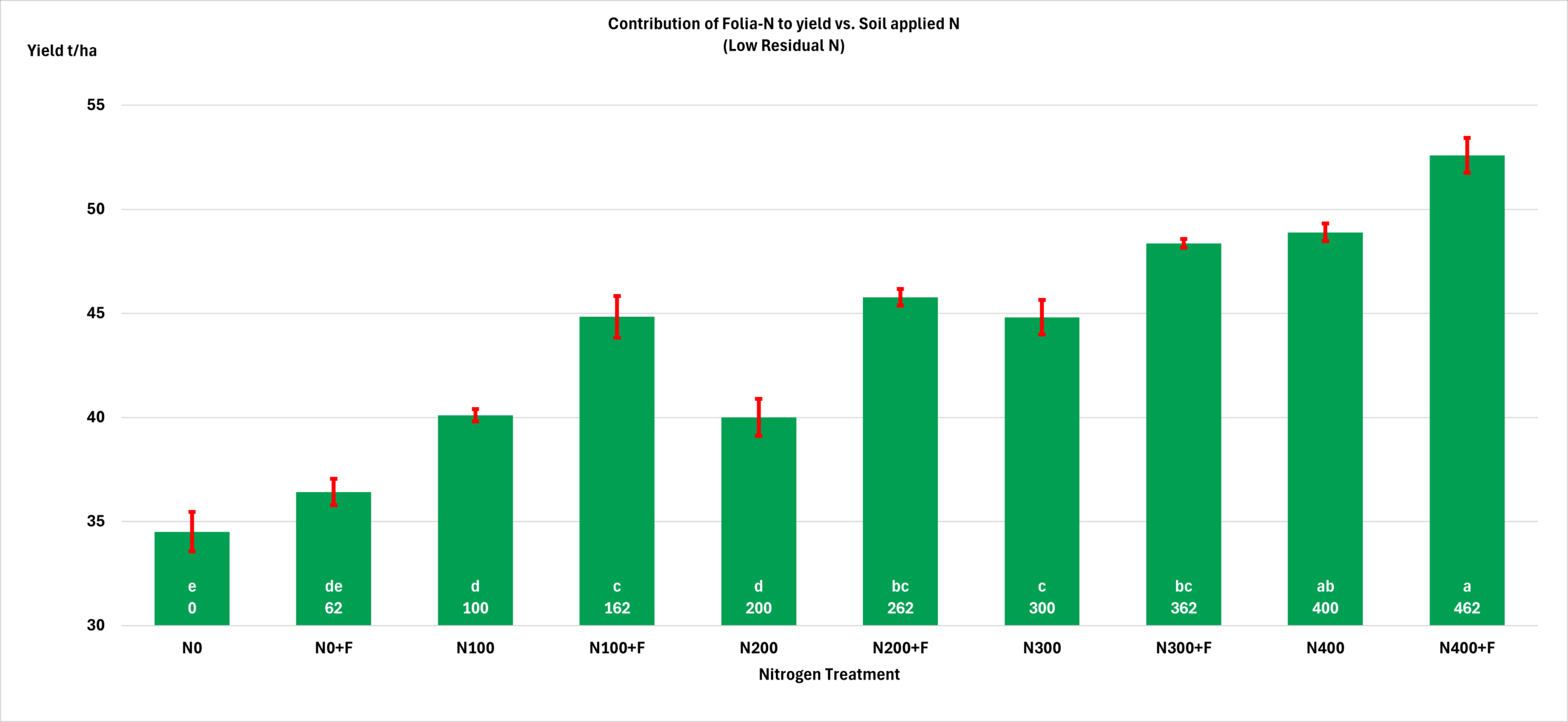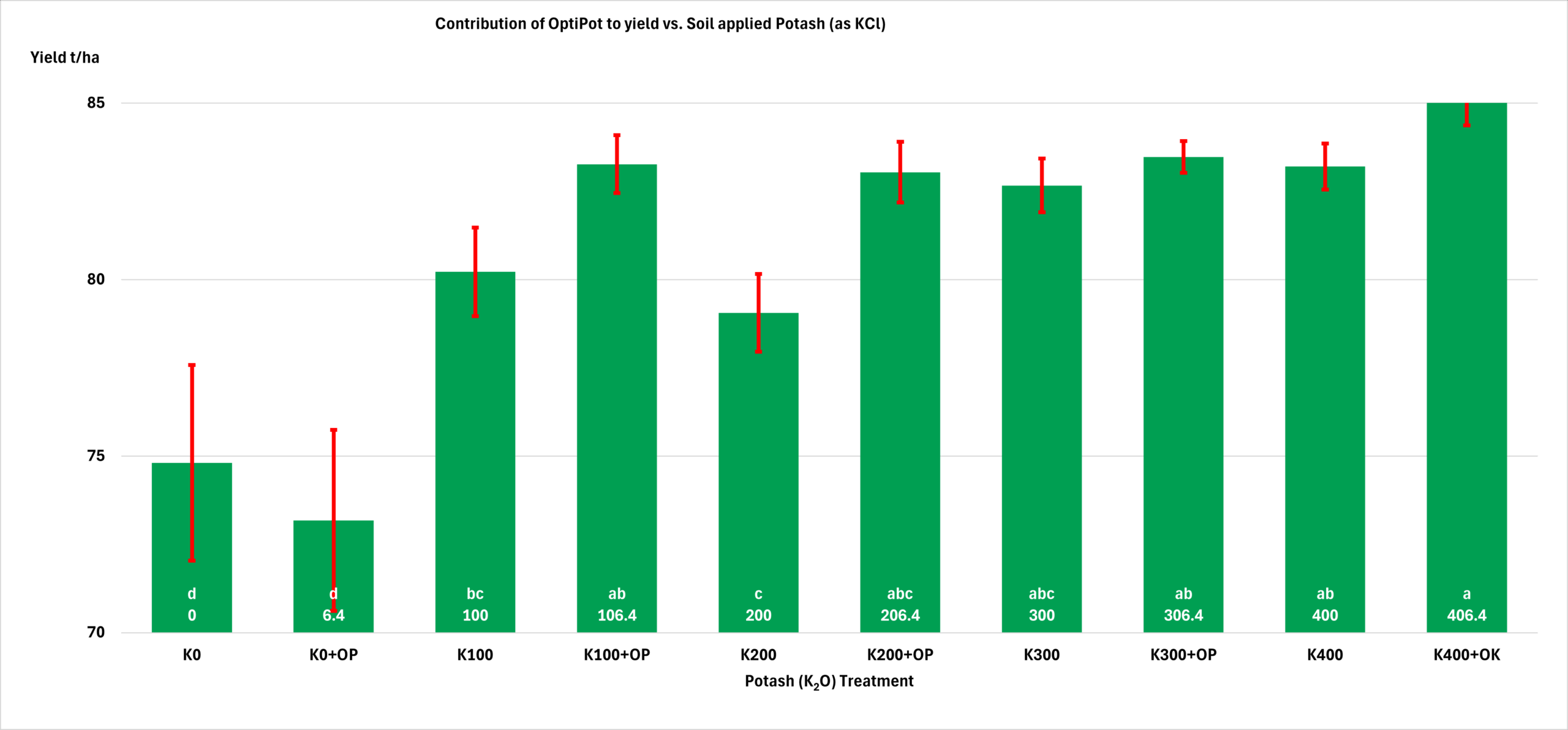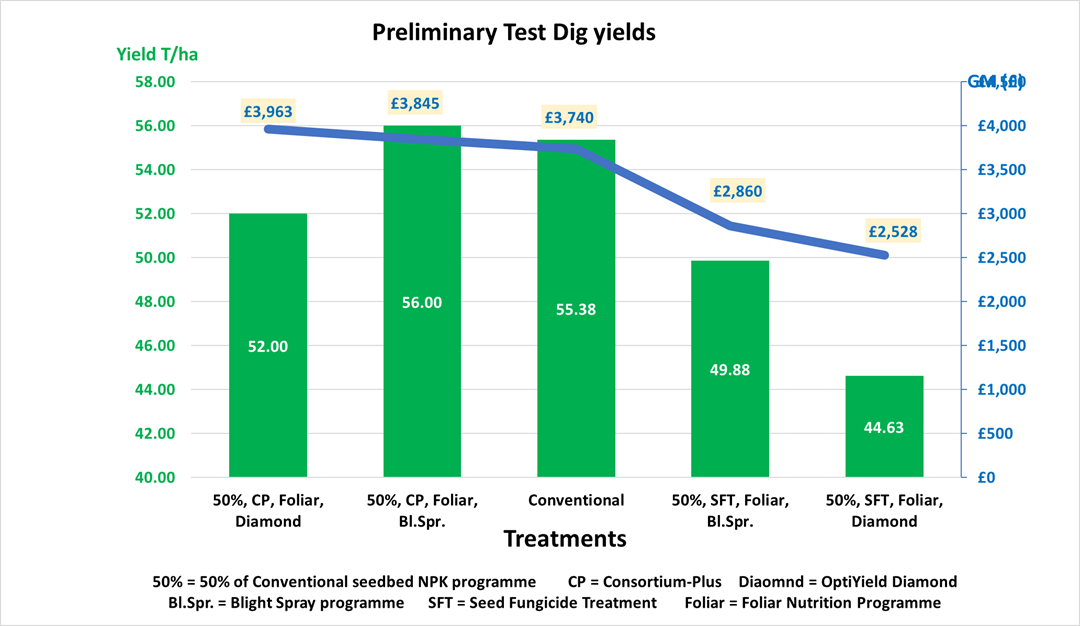One of the aims of the Transformative Reduced Input Potatoes (TRIP) Project is to evaluate ways to minimise the application of soil-applied inputs and in particular nitrogen, phosphate and potassium. The main alternative to traditional methods of applying inputs via the soil is to use systems that deliver nutrients directly to the plant.
Foliar applications ensure direct and indirect cellular uptake through the stomata, trichomes, leaf wax layer (cuticula) or through movement in the xylem (passive) or phloem (active). The method that the plant will use is dependent on the product’s formulation, which is why the aim of the research is to achieve increased absorption rates and a means of translocation to the growing points to improve nutrient use efficiency (NUE).
Foliar applications have been used for over thirty years, but there is still scepticism in their effectiveness when it comes to applying nitrogen, phosphate and other nutrients in this way. This scepticism is often based on historic issues such as leaf scorch, low dose application resulting in the need for several passes, as well as the need for specific weather conditions or a perceived lack of effectiveness.
As it is with Crop Protection Products (CPP), formulation is key to success with foliar applied nutrients and biostimulants. The right mix of active ingredients requires significant, thorough and meticulous formulation in order to deliver them safely and efficiently to the right targets within the plant.
Within the TRIP project, work has been led by Simon Fox, MD of Emerald Research Ltd (ERL), to develop and optimise plant nutrition formulations that offer easy uptake and assimilation by the crop and that can be delivered directly to the crop canopy via foliar sprays. Through optimising the plant’s ability to utilise the nutrients applied through foliar applications, there is a huge potential to reduce ‘nutrient over application’ which is not uncommon with standard nitrogen and phosphate recommendations.
To enable farmers and growers to feel confident in foliar applications, their concerns around using them on farm must be addressed, so the TRIP team has looked at developing formulations that:
- Are rapidly rain-fast and absorbed – removing concerns around weather intervals
- Have low to zero scorch characteristics – preventing detrimental crop damage
- Can be mixed with CPPs – removing the need for repeated tractor passes
- Have high Nutrient Use Efficiency (NUE)
To meet the above criteria, all nutrient candidate’s assays go through rigorous laboratory and glass-house trials on varying crops before they are trialled in field plots, from which the top performing assays are taken forwards to strip trials. Having carried out much of this work during the first year of the project, the best products were selected to go forwards for randomised plot tests in 2024.
As part of the 2024 season’s trials, Dyson Farming Research (DFR) conducted replicated plot trials comparing potato yield responses to soil applied versus soil plus foliar applied nitrogen, phosphate or potassium.
Randomised crop plot trials
Nitrogen
DFR conducted two nitrogen trials: one on a low organic matter site and the other on a high organic matter site.
Field Trials: Nitrogen applications at low organic matter site results t/h.

Dyson Farming Research 2024, cv. Lanoma, 3 Replicates. Soil with low mineral N (50kg N/ha) and organic matter (3.0% loss on ignition). Figures within the bars indicate total amount of nitrogen applied (kg N / ha). Columns which do not share a common letter differ significantly (Fisher’s LSD, P < 0.05).
Field Trials: Nitrogen applications at high organic matter site results t/ha.

Dyson Farming Research 2024, cv. Mozart, 3 Replicates. Soil with high residual mineral N (123kg N/ha) and organic matter (16.8% loss on ignition). Figures within the bars indicate total amount of nitrogen applied (kg N / ha). Columns which do not share a common letter differ significantly (Fisher’s LSD, P < 0.05).
Both experiments showed improved nutrient use efficiency of the directly applied 62 kg / ha of nitrogen, combined with the benefit of no additional environmental losses to soil or water.
On the low organic matter site, application of 100 kg N / ha to soil, plus 62 kg N / ha to the foliage, gave a yield equivalent to 300 kg N / ha applied to soil. On the high organic matter site, application of 100 kg N / ha to soil, plus 62 kg N / ha to the foliage, gave a yield equivalent to 200 kg N / ha applied to soil, while combining the foliar treatment with 200 kg N / ha applied to soil gave a yield equivalent to 300 kg N / ha applied to soil.
Field Trials: Phosphate applications site results t/ha.

Dyson Farming Research 2024, cv. Melody, 3 replicates. Soil phosphorus: 10.8 mg P/litre (P Index 1). Figures within the bars indicate total amount of phosphate applied (kg P2O5 / ha). Columns which do not share a common letter differ significantly (Fisher’s LSD, P < 0.05).
In reviewing the above results, it is possible to see that again direct application of phosphate to the leaf has a beneficial effect on yield, with equivalent results from treatments P200+SP and P300. By avoiding the soil as a means of nutrient transport, the direct application ensures rapid use and avoids soil lock up.
Field Trials: Potassium applications results t/ha.

Dyson Farming Research 2024, cv. Melody, 3 replicates. Soil potassium 190 mg K/Litre (K index 2+). Figures within the bars indicate total amount of potash applied (kg K2O / ha). Columns which do not share a common letter differ significantly (Fisher’s LSD, P < 0.05).
In this experiment, there was little response to application of more than 100 kg K2O / ha to soil. However, a comparison of all treatments with potash applied to soil against potash applied to soil plus foliage, showed a significant yield response to the foliar application, again demonstrating efficient use of foliar applied nutrients.
Commercial on-farm trials
Running concurrently with DFR randomised plot trials, the project also trialled these foliar products as part of a systematic approach to reducing overall input levels on farm. Strip trials were undertaken which looked at assessing the practicalities of implementing this approach of nutrient stacking using foliar application, and the impact on yield and gross margin.
The trials were laid out as follows:
| Base Nutrition | Planting | Foliar Nutrition | Other Foliar | |
| T1 | 50% NPK Seedbed | Consortium-Plus | OptiYield N&P | Standard |
| T2 | 50% NPK Seedbed | Seed fungicide treatment | OptiYield N&P | Standard |
| T3 | 50% NPK Seedbed | Consortium-Plus | OptiYield N&P | Diamond |
| T4 | 50% NPK Seedbed | Seed fungicide treatment | OptiYield N&P | Diamond |
| Control | 100% Std. | Seed fungicide treatment | None | Standard |
The results below demonstrated that it is possible to reduce the levels of nitrogen and phosphate input, with no detrimental loss of yield but with an improved gross margin.

Colwith Farm Potatoes, c.v.Endeavor Cornwall 2024. Gross margin calculated using £160/t for potatoes.
The advantages of foliar applications
Aside from the reduction in inputs through the improved nutrient use efficiency as well as yield responses and improved gross margin, foliar applications offer several additional benefits:
Reduction in the total volume of nitrogen
Work though bodies such as Rothamsted, AHDB and ADAS has shown that nutrient use efficiency (NUE) of soil-applied nitrogen is typically 55% or less for many crops, and even lower for potatoes, due to their shallow and poorly developed root system. Later top dressings have an even lower in NUE.
The TRIP research supports a growing body of evidence that has demonstrated time and again that a NUE of 90% or more can be achieved from foliar-applied nutrients, including nitrogen, allowing farmers and growers to reduce their overall nitrogen applications by up to 35%.
This can be realised because it is directly applied to the leaves, bypassing the need for the nitrogen to pass into the soil, where it risks being washed away, volatilisation as ammonia or nitrous oxide, being leached through the soil and into watercourses.
Immediate uptake
Macro and micronutrient applications are timed to meet a crop’s increased need for energy at each growth stage and as such foliar applications can ensure immediate uptake and use. Without having to rely on rain /dew required to dissolve soil-applied products, foliar uptake minimises the time delay between application and crop use.
Reduced environmental impact
The precision application of treatments to the leaf area significantly reduces the level of inputs that come into direct contact with the soil.
In the case of nitrogen, this minimises run-off caused by heavy rain, which in turn contributes to a reduction in the build-up of nitrates in watercourses and the resulting algae blooms.
With regard to phosphate, it is a practical way to prevent losses through soil lock-up attributed to ‘nutrient over application’ and therefore the waste of a finite resource shipped to the UK. Using less with increased effectiveness reduces business exposure to changes in trade agreements, while minimising environmental impact.
Improved soil health
By feeding the crop rather than the soil, soil health is not impaired through excess chemical applications, allowing the soil’s existing microbial colonies to survive and thrive throughout the growing season. This continues to support root mass development, which is essential to maximising nutrient uptake from the existing soil reserves.
Environmental emissions
Volatilisation of unused soil-applied nitrogen as ammonia or nitrous oxide contributes towards the UK greenhouse gas (GHG) emissions. Therefore, reducing the level of soil applied nitrogen will support UK farming’s journey towards Net Zero.
Advances in the formulation of foliar applied nutrients and greater accuracy in soil analysis techniques are driving the increased uptake of foliar applied products. Although the improvements in crop quality and yield would be sufficient to convince most growers, the additional environmental and sustainability benefits of foliar applications should also be encouraged in an industry that has many challenges meeting sustainability, reduced pollution and Net Zero goals.
